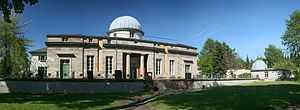Göttingen Observatory
| Göttingen Observatory | |
|---|---|
 | |
| Location | Göttingen, Germany |
| Coordinates | 51°31′42.54″N 9°56′35.8″E / 51.5284833°N 9.943278°ECoordinates: 51°31′42.54″N 9°56′35.8″E / 51.5284833°N 9.943278°E |
| Established | 1816 |
| Website | http://www.astro.physik.uni-goettingen.de/index.de.html |
Göttingen Observatory (Universitätssternwarte Göttingen (Göttingen University Observatory) or königliche Sternwarte Göttingen (Royal Observatory Göttingen)) is a German astronomical observatory located in Göttingen, Lower Saxony, Germany.
History
In 1802, George III of the United Kingdom, who was also was the prince-elector of Hanover, allocated 22,680 thalers for a new observatory. However, its construction was delayed by the French Revolutionary Wars and extended from 1803 until 1816. Carl Friedrich Gauß became the first director of the Observatory. Some problems of the building were fixed by renovations between 1887 and 1888. Due to the construction of a new telescope at Hainberg. observations at Göttingen Observatory were halted in 1933. The Observatory buildings were used by the University and after renovations, most recently in 2005, they were restored to their original appearance.[1] Since 2009, the Observatory has housed the Lichtenberg-Kolleg Institute for Advanced Study.[2]
Outposts
To improve observations, a new observatory was planned on the Hainberg, a small hill south east of Göttingen. After the opening of a new observatory there in 1929, the instruments were transferred from Göttingen to this new location. In 1941, during World War II, Paul ten Bruggencate became the director of the Göttingen University Observatory. In pursuit of his interest in observing the Sun, he looked for a new solar telescope. With the help of the military, he was able to build a solar telescope near the already existing telescope at Hainberg.[3][4] Unsatisfied with the cloudy weather conditions in Germany, ten Bruggencate established another solar observatory in Switzerland: the Locarno Observatory was planned and built in the late 1950s.[5] It was closed in 1984 and the equipment was transferred to the Teide Observatory in Tenerife, Spain,[6] where the University of Göttingen now shares the operation of several solar telescopes.
See also
References
- ↑ Borheck, Georg Heinrich; Beuermann, Klaus (2005). Grundsätze über die Anlage neuer Sternwarten unter Beziehung auf die Sternwarte der Universität Göttingen. Universitätsverlag Göttingen. ISBN 978-3-938616-02-4.
- ↑ http://www.uni-goettingen.de/en/observatory/91323.html
- ↑ Jäger, F. W. (1962). "Nachruf auf P. ten Bruggencate". Mitteilungen der Astronomischen Gesellschaft 15: 21–23. Bibcode:1962MitAG..15...21J.
- ↑ Kienle, H. (1962). "Paul ten Bruggencate 24.2.1901 14.9.1961". Die Naturwissenschaften 49 (4): 73. Bibcode:1962NW.....49...73K. doi:10.1007/BF00622019.
- ↑ "Istituto Ricerche Solari Locarno". Retrieved 2010-04-25.
- ↑ "Das Gregory Coude Teleskop auf Teneriffa". University Göttingen. Retrieved 2010-04-25.